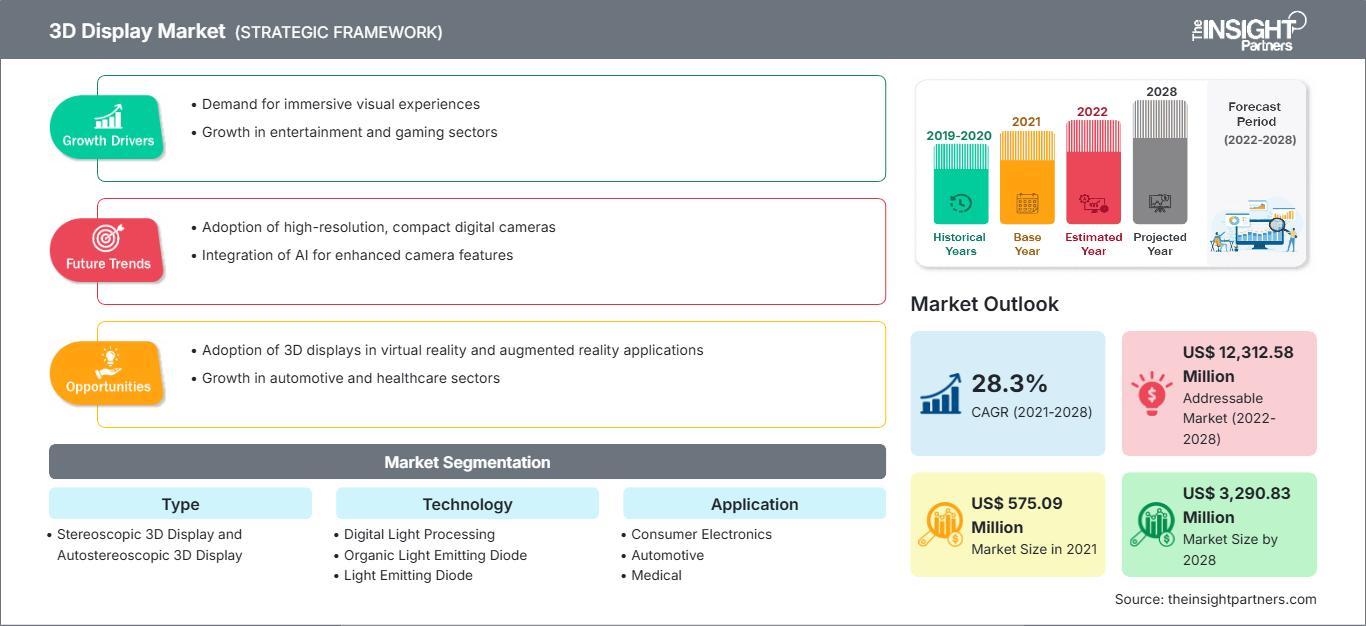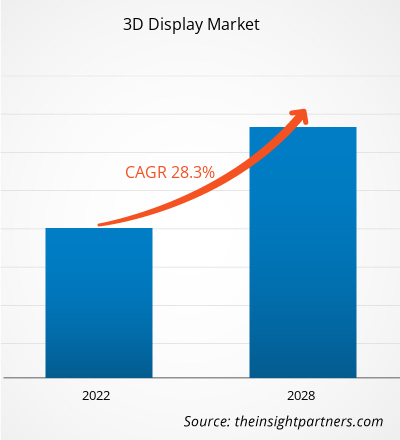Il mercato dei display 3D è stato valutato a 575,09 milioni di dollari nel 2021, per raggiungere i 3.290,83 milioni di dollari entro il 2028; si stima che registrerà un CAGR del 28,3% dal 2021 al 2028.
Elettronica di consumo, automotive, medicale, militare e difesa, industriale, media e intrattenimento e gaming sono tra i potenziali mercati per i display 3D. Inoltre, la crescita nei settori dell'intrattenimento e del gaming ha avuto un impatto positivo sul mercato dei display 3D, con un aumento significativo del numero di schermi cinematografici: circa 125.000 nel 2021 hanno iniziato a funzionare su una piattaforma digitale a livello globale. Inoltre, la crescente adozione della realtà aumentata in varie applicazioni mediche per migliorare le capacità visive dei chirurghi, ridurre i tempi operatori e la pianificazione preoperatoria sta creando opportunità per il mercato dei display 3D. Ad esempio, a maggio 2020, Ocutrx Vision Technologies, LLC ha annunciato lo sviluppo della sua nuova sala operatoria di visualizzazione chirurgica, "Ocutrx OR-Bot", dotata di un monitor 3D 8K per l'utilizzo degli strumenti chirurgici. Tuttavia, i continui investimenti, soprattutto in soluzioni di visualizzazione 3D autostereoscopiche, e il crescente numero di partnership tra operatori del mercato e utenti finali per lo sviluppo di sistemi di visualizzazione 3D olografici e volumetrici avanzati per un'ampia gamma di applicazioni, sono tra i fattori che guidano la crescita del mercato globale dei display 3D.
Personalizza questo rapporto in base alle tue esigenze
Potrai personalizzare gratuitamente qualsiasi rapporto, comprese parti di questo rapporto, o analisi a livello di paese, pacchetto dati Excel, oltre a usufruire di grandi offerte e sconti per start-up e università
Mercato dei display 3D: Approfondimenti strategici

- Ottieni le principali tendenze chiave del mercato di questo rapporto.Questo campione GRATUITO includerà l'analisi dei dati, che vanno dalle tendenze di mercato alle stime e alle previsioni.
Potrai personalizzare gratuitamente qualsiasi rapporto, comprese parti di questo rapporto, o analisi a livello di paese, pacchetto dati Excel, oltre a usufruire di grandi offerte e sconti per start-up e università
Mercato dei display 3D: Approfondimenti strategici

- Ottieni le principali tendenze chiave del mercato di questo rapporto.Questo campione GRATUITO includerà l'analisi dei dati, che vanno dalle tendenze di mercato alle stime e alle previsioni.
Impatto della pandemia di COVID-19 sul mercato dei display 3D
La crisi del COVID-19 ha colpito i settori industriali di tutto il mondo e l'economia globale ha subito il colpo più duro nel 2020, con un impatto che probabilmente continuerà anche nel 2021. L'epidemia ha creato notevoli disagi in settori primari come l'automotive, la vendita al dettaglio e l'elettronica di consumo. Il forte calo dell'elettronica e dell'industria manifatturiera sta influenzando la crescita del mercato globale dei display 3D. Il Nord America è una delle regioni più favorevoli all'adozione e alla crescita di nuove tecnologie grazie al sostegno delle politiche governative volte a promuovere l'innovazione, alla presenza di un'enorme base industriale e all'elevato potere d'acquisto, soprattutto nei paesi sviluppati come Stati Uniti e Canada. Il Nord America ospita un gran numero di aziende manifatturiere e tecnologiche, pertanto l'impatto dell'epidemia di COVID-19 è stato piuttosto grave fino alla metà del 2021. La regione prevede una ripresa del mercato e un miglioramento economico con le campagne di vaccinazione contro il COVID-19.
Approfondimenti di mercato - Mercato dei display 3D
Numero crescente di partnership industriali per stimolare la crescita del mercato
Le attuali principali aree di applicazione dei display 3D sono il marketing e la pubblicità. Si prevede che i settori medico, automobilistico e della difesa saranno tra i potenziali settori per i display 3D. Le potenziali aree di applicazione delle tecnologie di visualizzazione 3D potrebbero essere senza precedenti, a seconda della crescita positiva e dello sviluppo tecnologico del mercato.
Approfondimenti basati sulla tipologia
In base alla tipologia, il mercato dei display 3D è segmentato in display 3D stereoscopico e display 3D autostereoscopico. Il segmento dei display 3D autostereoscopici ha detenuto una quota di mercato maggiore nel 2021.
Gli operatori che operano nel mercato dei display 3D si concentrano principalmente sullo sviluppo di prodotti avanzati ed efficienti.
- Nell'aprile 2021, AUO ha lanciato una straordinaria serie di display ALED al Touch Taiwan 2021, con tecnologia micro LED leader a livello mondiale e applicazioni in mostra.
- A settembre 2021, il display estensibile di Samsung può trasformare contenuti 2D in scene 3D in movimento.
Approfondimenti regionali sul mercato dei display 3D
Le tendenze e i fattori regionali che influenzano il mercato dei display 3D durante il periodo di previsione sono stati ampiamente spiegati dagli analisti di The Insight Partners. Questa sezione analizza anche i segmenti e la geografia del mercato dei display 3D in Nord America, Europa, Asia-Pacifico, Medio Oriente e Africa, America Meridionale e Centrale.
Ambito del rapporto sul mercato dei display 3D
| Attributo del rapporto | Dettagli |
|---|---|
| Dimensioni del mercato in 2021 | US$ 575.09 Million |
| Dimensioni del mercato per 2028 | US$ 3,290.83 Million |
| CAGR globale (2021 - 2028) | 28.3% |
| Dati storici | 2019-2020 |
| Periodo di previsione | 2022-2028 |
| Segmenti coperti |
By Tipo
|
| Regioni e paesi coperti | Nord America
|
| Leader di mercato e profili aziendali chiave |
|
Densità degli operatori del mercato dei display 3D: comprendere il suo impatto sulle dinamiche aziendali
Il mercato dei display 3D è in rapida crescita, trainato dalla crescente domanda degli utenti finali, dovuta a fattori quali l'evoluzione delle preferenze dei consumatori, i progressi tecnologici e una maggiore consapevolezza dei vantaggi del prodotto. Con l'aumento della domanda, le aziende stanno ampliando la propria offerta, innovando per soddisfare le esigenze dei consumatori e sfruttando le tendenze emergenti, alimentando ulteriormente la crescita del mercato.

- Ottieni il Mercato dei display 3D Panoramica dei principali attori chiave
Il mercato dei display 3D è segmentato in base a tipologia, tecnologia, applicazione e area geografica. In base alla tipologia, il mercato è suddiviso in display 3D stereoscopici e display 3D autostereoscopici. Nel 2021, il segmento dei display 3D autostereoscopici ha guidato il mercato dei display 3D e ha rappresentato la quota di mercato maggiore. In base alla tecnologia, il mercato è suddiviso in elaborazione digitale della luce, diodi organici a emissione luminosa e diodi a emissione luminosa. Nel 2021, il segmento dell'elaborazione digitale della luce ha guidato il mercato dei display 3D e ha rappresentato la quota di mercato maggiore. In base all'applicazione, il mercato è segmentato in elettronica di consumo, automotive, medicale, pubblicità, vendita al dettaglio, militare e difesa e altri settori. Nel 2021, il segmento dell'elettronica di consumo ha guidato il mercato dei display 3D e ha rappresentato la quota di mercato maggiore. Geograficamente, il mercato è ampiamente segmentato in Nord America, Europa, Asia-Pacifico (APAC), Medio Oriente e Africa (MEA) e Sud America (SAM). Nel 2021, il Nord America ha rappresentato una quota significativa del mercato globale.
Tra i principali fornitori del mercato globale dei display 3D figurano aziende come AU OPTRONICS CORP, Innolux Corporation, LG Electronics, Mitsubishi Electric Corporation, Panasonic Corporation, Samsung Group, Sharp Corporation, Looking Glass Factory Inc, Light Field Lab Inc, Leia Inc, Sony, Toshiba Corporation e Fujifilm Corporation.
- Analisi storica (2 anni), anno base, previsione (7 anni) con CAGR
- Analisi PEST e SWOT
- Valore/volume delle dimensioni del mercato - Globale, Regionale, Nazionale
- Industria e panorama competitivo
- Set di dati Excel
Report recenti
Rapporti correlati
Testimonianze
Motivo dell'acquisto
- Processo decisionale informato
- Comprensione delle dinamiche di mercato
- Analisi competitiva
- Analisi dei clienti
- Previsioni di mercato
- Mitigazione del rischio
- Pianificazione strategica
- Giustificazione degli investimenti
- Identificazione dei mercati emergenti
- Miglioramento delle strategie di marketing
- Aumento dell'efficienza operativa
- Allineamento alle tendenze normative




















 Ottieni un campione gratuito per - Mercato dei display 3D
Ottieni un campione gratuito per - Mercato dei display 3D